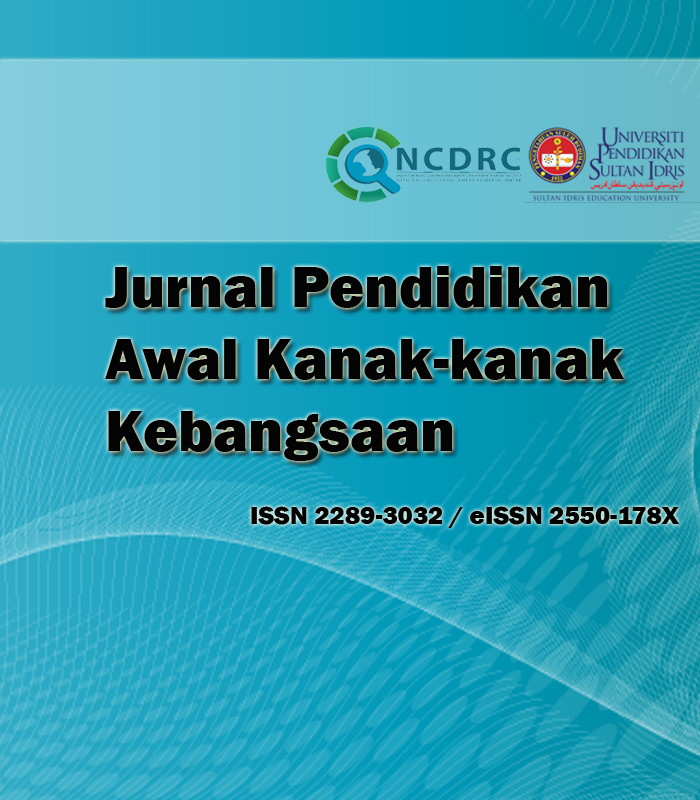Ulasan buku: “Engkaulah adiwiraku: Bagaimana kanak-kanak boleh melawan COVID-19!”
Book review: “My hero is you: How kids can fight COVID-19!”
DOI:
https://doi.org/10.37134/jpak.vol9.1.5.2020Keywords:
adiwira, ilustrasi, seni bina halaman, superheroes, COVID-19, illustrations, pragmatic on the page, page achitectureAbstract
Buku ini merupakan bahan bacaan untuk kanak-kanak berumur 6 hingga 11 tahun yang berkaitan bagaimana kanak-kanak boleh menjadi seorang adiwira dalam memahami serta menangani wabak pandemik Coronavirus Disease 2019 (COVID-19). Watak utama ialah seorang kanak-kanak perempuan bernama Sara bersama ibunya yang merupakan seorang saintis yang berperanan untuk menangani COVID-19. Buku ini menyerlahkan konteks situasi kanak-kanak yang berimaginasi untuk melaksanakan sesuatu menurut tafsiran dan pengalamannya. Dalam mimpinya, Sara bertemu dengan seekor naga, iaitu Ario yang membawanya terbang merentasi sempadan negara untuk menyelami perasaan kanak-kanak lain dalam memahami dan menghadapi COVID-19. Dalam pengembaraan ini, Sara dan Ario saling berkongsi nasihat serta pengalaman dengan beberapa orang kanak-kanak lagi, iaitu Salem, Sasha, Leila dan Kim dalam usaha menghadapi COVID-19. Buku ini turut mempersembahkan ekspresi linguistik yang signifikan dengan topik serta ilustrasi lakaran watak yang menarik, di samping menunjukkan langka-langkah untuk menangani COVID-19. Visual ilustrasi yang ditunjukkan dapat menyerlahkan ‘pragmatic on the page’ dan seni bina halaman yang menarik bagi memberi tarikan dalam bahan bacaan kanak-kanak. Secara keseluruhan, buku ini dapat menyerlahkan nilai keharmonian masyarakat, nilai kasih sayang dalam keluarga, dan menonjolkan sifat adiwira setiap watak yang terdapat dalam buku ini. Buku ini diharap dapat menjadi medium pengetahuan secara bahan bacaan ringan untuk keluarga dalam mendidik anak-anak memahami dan menangani COVID-19.
This book is a reading material for children aged 6 to 11 years old about how children can be super heroes in understanding and overcoming the Coronavirus Disease 2019 (COVID-19) pandemic. The main character is a girl, Sara, who interacts with her mother, a scientist to overcome COVID-19. This book has also highlighted the context of children’s situation about her imagination in taking actions based on her interpretations and experiences. In her dream, she met a dragon, Ario that flew her across countries to dive into other children’s feelings in understanding and facing the COVID-19. In the adventure, Sara and Ario shared each other’s advices and experiences with some other children, Salem, Sasha, Leila and Kim, in their efforts to overcome the COVID-19. This book has also presented linguistics expressions significant to the topic and interesting illustrations of characters sketches by showing the correct way to avoid the COVID-19. Visual illustrations included have highlighted pragmatic on the page and interesting page architecture for attractions in children’s reading materials. Overall, this book is able to highlight the harmonious values of the community, the values of love in a family, and apart from the supernatural powers of each character in the book. This book is hoped to be the medium of knowledge as light reading material for families in educating their children to understand and overcome the COVID-19.
Downloads
References
Bahrick, L., Parker, J. F., Fivush, R., & Levitt, M. (1998). Children's memory for Hurricane Andrew. Journal of Experimental Psychology: Applied, 4, 308-331.
Broadhurst, K., Alrouh, B., Yeend, E., Harwin, J., Shaw, M., Pilling, M., Mason, C., & Kershaw, S. (2015). Connecting events in time to identify a hidden population: Birth mothers and their children in recurrent care proceedings in England. The British Journal of Social Work, 45(8), 2241–2260. https://doi.org/10.1093/bjsw/bcv130
Clegg, J. M., & Legare, C. H. (2016). Instrumental and conventional interpretations of behavior are associated with distinct outcomes in early childhood. Child Development, 87, 527–542
Gopnik, A., & Wellman, H. M. (2012). Reconstructing constructivism: Causal models, Bayesian learning mechanisms, and the theory theory. Psychological Bulletin, 138, 1085–1108. http://dx.doi.org/10.1037/a0028044
Harris, P. L., & Koenig, M. A. (2006). Trust in testimony: How children learn about science and religion. Child Development, 77, 505–524.
Inter-Agency Standing Committee. (2020). Engkaulah adiwiraku: Bagaimana kanak-kanak boleh melawan COVID-19! (Feisul Idzwan Mustapha, Penterjemah). Creative Commons Attribution-NonCommercial-ShareAlike 3.0 IGO. https://www.who.int/news-room/detail/09-04-2020-children-s-story-book-released-to-help-children-and-young-people-cope-with-covid-19
Kenward, B. (2012). Over-imitating preschoolers believe unnecessary actions are normative and enforce their performance by a third party. Journal of Experimental Child Psychology, 112, 195–207. http://dx.doi.org/10.1016/j.jecp.2012.02.006.
Leblond, D. (2019). Visual pragmatics of intertextuality: Ghosts from wonderland in Jeanette Winterson’s Gut Symmetries (1997). Textual Practice. https://doi.org/ 10.1080/0950236X.2019.1580212
Leinonen, E., Letts, C., & Smith, B. R. (2000). Children`s Pragmatic communication difficulties. Whurr Publishers.
Levine, S. C., Ratliff, K. R., Huttenlocher, J., & Cannon, J. (2011). Early PuzzlePlay: A predictor of preschoolers' spatial transformation skill. Developmental Psychology. Advance online publication. https://doi.org/doi: 10.1037/a0025913
Mak, B. (2011). How the page matters. U of Toronto P.
Paradise, R., & Rogoff, B. (2009). Side by side: Learning by observing and pitching in.Ethos, 37, 102–138. http://dx.doi.org/10.1111/j.1548-1352.2009.01033.x
Peterson, C, & Bell, M. (1996). Children's memory for traumatic injury. Child Development, 67, 3045-3070.
Ronfard, S., Bartz, D., Cheng, L., Chen, X., & Harris, P. L. (2017). Children’s developing ideas about knowledge and its acquisition. Advances in Child Development and Behavior. http://dx.doi.org/10.1016/bs.acdb.2017.10.005.
Sarudin, A., Mohamed Redzwan, H. F., Osman, Z., Raja Ma’amor Shah, R. N. F., & Mohd Ariff Albakri, I. S. (2019). Menangani kekaburan kemahiran prosedur dan terminologi awal Matematik: Pendekatan leksis berdasarkan teori prosodi semantik. Malaysian Journal of Learning and Insruction, 16(2), 255-294.
Taisin, N. J. (2018). Aktiviti melukis meningkatkan keyakinan diri dalam kalangan kanak-kanak. Jurnal Pendidikan Awal Kanak-Kanak Kebangsaan, 7, 19-29. https://ejournal.upsi.edu.my/index.php/JPAK/article/view/909
Thirumalaisamy, P. V., & Meyer, C. G. (2020). The COVID-19 epidemic. Tropical Medicine and International Health, 25(3), 278–280. http://doi:10.1111/tmi.13383
Vandermaas, M. O., Hess, T. M., & Baker-Ward, L. (1993). Does anxiety affect children's reports of memory for a stressful event? Applied Cognitive Psychology, 7(2), 109-127. https://doi.org/10.1002/acp.2350070204





